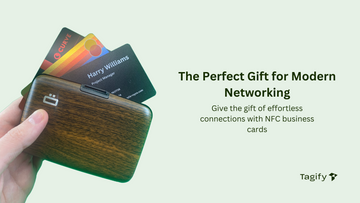Is NFC Data Secure?

Ensuring Data Security with NFC and QR Codes
NFC (Near Field Communication) and QR (Quick Response) codes are increasingly popular technologies for sharing information quickly and easily. From digital business cards to contactless payments and product information, both NFC tags and QR codes offer convenience in various settings. However, as their use becomes more widespread, questions about data security arise. How safe is it to transfer information via NFC and QR codes?
This article provides an overview of how these technologies work and the level of security they offer.
How NFC and QR Codes Work
Both NFC and QR codes are designed to give users quick access to information by linking to a URL or online resource. Here’s a breakdown of each technology:
-
NFC (Near Field Communication): NFC allows devices to communicate wirelessly when they’re in close proximity, usually within a few centimeters. By tapping an NFC-enabled device (such as a smartphone) on an NFC tag, users can access the information stored on that tag—typically, a URL that redirects them to a website or app.
-
QR (Quick Response) Codes: QR codes are 2D barcodes that can be scanned by a smartphone camera. When scanned, the code directs users to a URL or other information linked to that code. QR codes are commonly used on printed materials, packaging, and displays.
In both cases, NFC tags and QR codes generally store a link, not the actual data itself. When tapped or scanned, they direct users to an online location where the data is hosted.
Are NFC and QR Code Data Transfers Secure?
One of the main concerns when using NFC and QR codes is data security. Here are the key points to consider:
-
No Built-In Encryption: NFC and QR codes themselves do not have built-in encryption. They merely act as shortcuts to a URL or an online resource. When you tap an NFC tag or scan a QR code, the device retrieves the URL stored in the code, without any encryption at the code level.
-
Security Depends on the Website or Platform: The security of the data accessed via NFC or QR codes relies on the website or platform where it’s stored. If the URL linked to the NFC or QR code uses HTTPS, a secure protocol, it encrypts the data during transmission, protecting it from unauthorized access or interception.
-
HTTPS Encryption is Key: When using NFC or QR codes, make sure the URL you’re linking to is HTTPS-enabled. HTTPS adds a layer of encryption, ensuring that data is securely transmitted between the website and the user’s device. This encryption makes the connection private and difficult for unauthorized users to intercept.
Best Practices for Secure Use of NFC and QR Codes
If you’re using NFC or QR codes in any context—whether for personal, business, or public purposes—following these best practices can help keep your data secure:
-
Use HTTPS for Linked URLs: Always ensure the URL linked to your NFC tag or QR code starts with HTTPS. This encrypts the connection and protects the data from being intercepted or tampered with.
-
Choose Reputable Platforms for Storing Data: Use trusted platforms for hosting any sensitive information accessed via NFC or QR codes. Many secure online services follow industry best practices for data protection and prevent unauthorized access.
-
Limit Direct Data Storage on Tags: Instead of storing sensitive information directly on an NFC tag or QR code, use these technologies as links to secure, encrypted websites or platforms. This way, even if someone gains access to the NFC tag or QR code, they won’t be able to retrieve any sensitive data from the code itself.
-
Educate Users on Safe Scanning Practices: When deploying QR codes or NFC tags in public, inform users to only tap or scan codes they trust. This helps prevent phishing attempts, where malicious actors may use fake QR codes to lead users to unsafe websites.
Final Thoughts
NFC and QR codes provide fast, easy access to digital information, making them invaluable tools for both personal and business use. However, it’s important to remember that neither NFC nor QR codes inherently encrypt data—the security of the information ultimately depends on the website or platform where it’s stored. By using HTTPS-enabled URLs, reputable platforms, and following general best practices, you can ensure that your NFC and QR code interactions remain secure.
As these technologies continue to grow in popularity, understanding the basics of data security can help you use NFC and QR codes with confidence, keeping your information safe and accessible.









